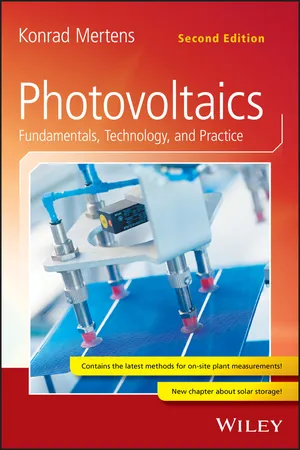
Photovoltaics
Fundamentals, Technology, and Practice
Konrad Mertens
- English
- ePUB (disponibile sull'app)
- Disponibile su iOS e Android
Photovoltaics
Fundamentals, Technology, and Practice
Konrad Mertens
Informazioni sul libro
A comprehensive tutorial on photovoltaic technology now fully updated to include solar storage and the latest methods for on-site plant measurements
Starting with the basic principles of solar energy, this fully updated, practical text explains the fundamentals of semiconductor physics and the structure and functioning of the solar cell. It describes the latest measurement techniques for solar modules, and the planning and operation of grid-connected and off-grid PV systems.
It also looks at other thin film cells, hybrid wafer cells, and concentrator systems. Additionally, this Second Edition covers solar modules and solar generators; system technology of grid connected plants; the storage of solar energy; photovoltaic measurement technology; the planning and operation of grid-connected systems; economic efficiency of PV systems; and the future development of PV.
- Presents the latest advances in PV R&D and industry deployment
- Updated illustrations and tabular data reflect current state-of-the-art and PV technology efficiencies
- Offers expanded tutorial sections to aid teaching and self-study
- Includes a brand-new chapter on Solar Energy Storage
- Features two enlarged chapters—one on up-to-date photovoltaic metrology and the other on the future developments in photovoltaics
- Comes along with the accompanying website www.textbook-pv.org which offers free downloadable figures of the book, solutions of exercises, additional free PV software etc.
Developed to prepare engineering students for the PV industry, this practical text is an essential PV primer.